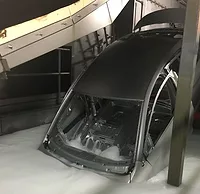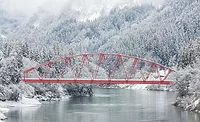Methodology for Developing Low-Temperature-Cure Accelerators
Two-component reactive epoxy-amine coating systems are widely used as maintenance and protective coatings (M&PC) due to their excellent chemical resistance, corrosion protection, adhesion and moisture barrier properties. However, sluggish rates of the epoxy-amine reaction at sub-ambient temperatures (less than 10 °C) result in coatings with excessively long dry times and improper cure. Consequently, such coatings do not provide the same level of protection as coatings applied and cured at higher temperatures. In this article, we highlight recent advances in improving cure speed at sub-ambient temperatures using new accelerators. Characterization of cure speed was performed by a novel methodology based on monitoring the coefficient of friction (COF) of the coating surface during cure. Results show that these accelerators significantly improve the cure speed under sub-ambient temperatures (less than 10 °C). Incorporation of these accelerators into liquid epoxy resin-based coating compositions may allow applicators to extend the painting season, especially in colder geographies.
Dry Time Recorder
Traditionally, a mechanical dry time recorder is used for measuring cure speed.1 In this technique, the coating is applied on a glass substrate using a film applicator. A needle is dragged through this coating from one end at a constant speed for 24 h until it reaches the other end. As the needle traverses through the coating it creates a scratch, the morphology of which is dependent on the stage of cure. Various stages of cure (set-to-touch, tack-free, dry hard, and dry through times) can be measured by locating the points of transition in the scratch morphology. The dry time recorder is easy to use and is widely used in the coatings industry; however, there are several practical challenges associated with utilizing this instrument to guide research. Firstly, the identification of transitions in the scratch morphology may not be trivial, as many of these transitions are ambiguous. As a result, the various stages of cure cannot be unequivocally discerned. In a few cases, certain transitions may not occur in the duration of the test, which makes interpretation of the cure stage difficult. Secondly, the variability of this technique can be very high. This poses a challenge, especially when conducting research such as developing alternative accelerators. Finally, the instrument is limited to monitoring cure only up to 24 h.
Cure Speed Characterization Using Friction Measurement
A new method for cure speed measurement based on friction measurement has been developed.2 COF, i.e., the ratio of the lateral force (FL) required to move a stainless steel ball probe (diameter = 9.5 mm) to the normal force (FN = 100 g) exerted on the probe, was measured on the coating surface by means of a tack and friction station equipped with lateral and normal load cells. COF can be measured accurately within 10% standard error. For a typical epoxy-amine coating, a characteristic pattern (Figure 1) can be generated when COF is plotted against cure time. During the initial stage, the coating components are unreacted and the viscosity is low. As a result, the COF recorded value is low. As the epoxy and amine components react, formation of a crosslinked network begins and the viscosity starts to rise. Consequently, the COF of the surface increases as cure progresses. At a certain point in the cure progression, the COF value peaks. As explained later in this section, this correlates well with the dry hard time of the coatings as measured on a conventional dry time recorder. As cure progresses further, the coating surface hardens, resulting in a drop in the COF value. Ultimately when the cure is completed, the COF reaches an equilibrium value, which is also the final COF of a completely cured coating.
In order to correlate this technique with the dry time recorder method, we plotted the dry hard time measured on the recorder against the time taken to reach peak COF value. Data were collected from six coatings made from the same epoxy resin and varying the curing agent. The coatings were clear coats prepared at a 1:1 amine NH:epoxy stoichiometric ratio. A linear trendline can be fitted along these data points, which has a slope of 0.973 (Figure 2). It can, therefore, be concluded that the time to reach the peak COF value is more or less equivalent to the dry hard time on the dry time recorder.
The technique was further enhanced by incorporating robotic controls to allow automated measurements on multiple coatings without user intervention. A high-throughput reactive coating station equipped with two programmable robotic arms was used to make the epoxy coatings. The robotic arms performed the required actions such as aspirate, dispense, weigh, mix and draw down. The coatings were then transferred to a thermal curing oven by means of a six-axis robot where they were allowed to cure for a pre-programmed time. The conditions inside the oven were set to the desired cure temperature (2 °C to 250 °C) and humidity conditions (5% to 95% RH). For ambient cure, the coatings were stored in an adjacent “hotel” for a specified cure time. Once the cure time elapsed, another six-axis robot carried the coating to the tack and friction station where COF measurements were taken.
Cure Speed at Sub-Ambient Temperature
Figure 3 shows the effect of cure temperature on the coating system prepared using a Mannich base curing agent (D.E.H.™ 615). When cured under ambient temperature, the COF peak occurs even before the first friction measurement is taken (at approximately 2 h). Equilibrium COF value is reached 5 h after the coating is made. When the cure temperature is dropped to 10 °C an increase in the dry hard time of ~6 h can be expected (peak to peak distance). When the cure temperature is further reduced to 5 °C, the dry time is drastically longer as can be seen from the COF peak, which occurs ~30 h after the coating is applied. It is, therefore, amply clear that when the cure temperature is reduced, a significant increase in the dry time is observed. Traditional accelerators such as tris-2,4,6-(dimethylaminomethyl)phenol, benzyl dimethylamine and salicylic acid are only mildly effective at reducing the dry times at sub-ambient temperatures. Therefore, we embarked on an effort to develop alternative accelerators to increase cure speed of epoxy-amine coatings at sub-ambient temperatures.
Alternative Low-Temperature Accelerators
A library of 30 potential accelerators was screened using the automated protocol. These accelerators were added at 1 wt.% on the hardener weight. Experiments were carried out using multiple resins and hardener systems; cure response was screened at ambient condition. Of the 30 candidates, four were shown to yield significant acceleration and were down-selected for the second round of testing for cure speed measurement at sub-ambient temperature.
Figure 4 shows the effect of the four accelerators on the cure speed of epoxy coatings (resin system B cured with D.E.H. 615). The coating containing accelerator C has a significantly higher cure speed relative to the cure speed of the control coating (i.e., no added accelerator), resulting in a 10-15 h reduction in the dry hard time (peak to peak difference). On the other hand, COF of the coating containing accelerator B monotonically increases during the 48 h cure time. This candidate, therefore, retards cure speed relative to the control when cure is carried out at sub-ambient temperature (≤5 °C) in contrast to the behavior at ambient temperature. Accelerator D containing coating shows sluggish initial cure (0-15 h), but has similar dry hard time as that of the control. Accelerator A does not have an impact on the cure speed at sub-ambient cure temperature (≤5 °C). However, we believe that this latter result is due to lack of solubility of this candidate in the coating formulation at low temperature.
Figure 5 shows the effect of the four accelerators on the cure speed of coatings prepared from epoxy resin system A and D.E.H. 615 when cure is performed at sub-ambient temperature. Again, accelerator C shows an improvement in the cure speed of the coating relative to the control, resulting in a 15-20 h reduction in the dry hard time. Other accelerators, however, do not improve the cure speed relative to the control.
Conclusion
Friction measurements on reactive epoxy coatings during cure offer a quantitative indication of the cure rate. Compared to conventional methods for assessing dry times that rely on subjective operator ratings, the new method provides advantages for quantitatively assessing new strategies for accelerating cure. Moreover, cure speed characterization using friction measurement retains simplicity as compared to other analytical techniques such as dynamic mechanical analysis (DMA) or Fourier transform infrared (FTIR) spectroscopy. Automation of the friction technique using robotic controls enables efficient screening of accelerator candidates for low-temperature cure of epoxy coatings. Accelerator C showed improved cure speed at 5 °C when used with coating systems employing a Mannich base curing agent, resulting in a 10-20 h reduction in the dry hard time. Improved cure speed was observed in the two epoxy resins systems evaluated in this study. Future efforts will be directed at understanding the mechanism of cure acceleration and exploring chemical analogs of this accelerator to further increase the cure speed at sub-ambient temperatures. The knowledge gained will be extended to other epoxy/curing agent pairings as well as into fully formulated epoxy systems. n
References
1 ASTM Standard D5895-03: Standard Test Methods for Evaluating Drying or Curing During Film Formation of Organic Coatings Using Mechanical Recorders. ASTM International, West Conshohocken, PA (2008).
2 Timpe, S.J.; Kuo, T.C. Tribology Letters, Vol. 52, 2013, pp 105-112.
Acknowledgments
The authors thank Ralph Even, Tom Kalantar, Michael Tate, T.C. Kuo, Kevin Bouck, Erin Vogel, and Jia Tang for several helpful discussions. Authors also thank Tom Clark and Peter Margl for providing the library of accelerator candidates.
This paper was presented at the Coatings Trends and Technology Conference in Lincolnshire, IL September 2014.
™ Trademark of The Dow Chemical Company (“Dow”) or an affiliated company of Dow
By Niranjan A. Malvadkar, Jamie M. Weishuhn and Ray E. Drumright | The Dow Chemical Company, Midland, MI
Looking for a reprint of this article?
From high-res PDFs to custom plaques, order your copy today!








